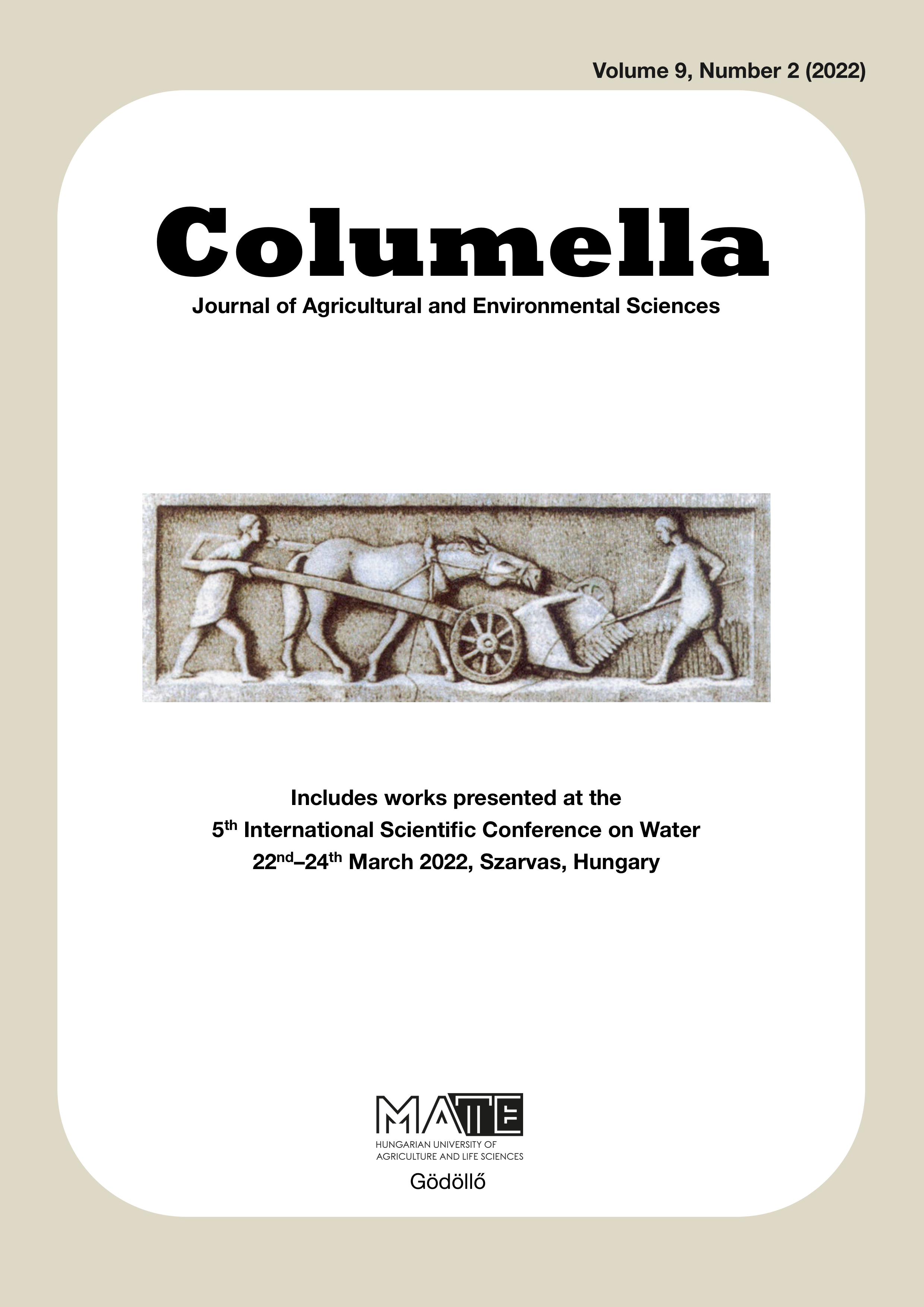Effect of irrigation and water quality on the physiological status of sugar beet and fodder beet using SPAD-502 chlorophyll meter
DOI:
https://doi.org/10.18380/SZIE.COLUM.2022.9.2.23Keywords:
relative chlorophyll content, sugar growth stage, accumulation stage, maximum canopy cover, canopy senescenceAbstract
In Hungary, irrigation determines the success of water-intensive beet cultivation. Taking into account the guidelines of the circular economy, we investigated the effect of irrigation with pre-treated nutrient-rich effluent from an intensive catfish-farm on the growth stages of sugar beet and fodder beet. In the two-year-experiment (2020, 2021), two sugar beet (‘Helenika’, ‘Grandiosa’) and two fodder beet (‘Rózsaszín Béta’, ‘Béta Vöröshenger’) cultivars were grown. In addition to the effluent water of the fish farm, the water of the Körös oxbow lake and a mixed water type (1:3 effluent and Körös water, added gypsum) were used for irrigation (sprinkler irrigation methods, 4 replications). The experiment was performed in 64 lysimeter vessels/units (1 m2) in Szarvas. During the research we sought answers to the following questions: (1) whether the onset and length of sugar growth stage and accumulation stage differ depending on water quality, (2) which beet variety has the highest relative chlorophyll content, (3) whether irrigation water quality affected the relative chlorophyll content of beet cultivars. SPAD values measured with the SPAD-502 chlorophyll meter were used to estimate the relative chlorophyll content of beet leaves.
References
Akeson, W. R., Westfall, D. G., Henson, M. A., & Stout, E. L. (1979). Influence of Nitrogen Fertility Level and Topping Method on Yield, Quality, and Storage Losses in Sugarbeets. Agronomy Journal 71(2), 292-297. doi: https://doi.org/10.2134/agronj1979.00021962007100020018x
Ghasemi, H., Esmaeili, M. A., & Mohammadian, R. (2017). Effects of nitrogen on chlorophyll fluorescence and the relationship between chlorophyll content and SPAD values in sugar beet (Beta vulgaris L.) under drip-tape system. Journal of Agricultural and Biological Science 12(3), 117-122.
Islam, M. J., Kim, J. W., Begum, M. K., Sohel, M. A. T., & Lim, Y.-S. (2020). Physiological and Biochemical Changes in Sugar Beet Seedlings to Confer Stress Adaptability under Drought Condition. Plants 9(11), 1511. doi: https://doi.org/10.3390/plants9111511
Kolozsvári, I., Kun, Á., Jancsó, M., Bakti, B., Bozán, C., & Gyuricza, C. (2021). Utilization of Fish Farm Effluent for Irrigation Short Rotation Willow (Salix alba L.) under Lysimeter Conditions. Forests 12(4), 457. doi: https://doi.org/10.3390/f12040457
KSH. (2022). Retrieved 16.03.2022, from https://www.ksh.hu/stadat_files/mez/hu/mez0081 .html
Moghaddam, P., Derafshi, M., & Shirzad, V. (2011). Estimation of single leaf chlorophyll content in sugar beet using machine vision. Turkish Journal of Agriculture and Forestry 35(6), 563- 568. doi: https://doi.org/10.3906/tar-0909-393
NÉBIH. (2022). Retrieved 16.03.2022, from https://portal.nebih.gov.hu/-/nemzeti -fajtajegyzekek
Posch, K. (Ed.). (1997). Amit a cukorrépáról tudni kell. Budapest: Agroinform Kiadó és Nyomda Kft.
Rombay, D. (1914). A cukorrépa. Budapest: Franklin Társulat.
Salehi, A., Tasdighi, H., & Gholamhoseini, M. (2016). Evaluation of proline, chlorophyll, soluble sugar content and uptake of nutrients in the German chamomile (Matricaria chamomilla L.) under drought stress and organic fertilizer treatments. Asian Pacific Journal of Tropical Biomedicine 6(10), 886-891. doi: https://doi.org/10.1016/j.apjtb.2016.08.009
Sims, D. A., & Gamon, J. A. (2002). Relationships between leaf pigment content and spectral reflectance across a wide range of species, leaf structures and developmental stages. Remote Sensing of Environment 81(2), 337-354. doi: https://doi.org/10.1016/S0034-4257(02)00010-X
Széles, A. (2008). SPAD-érték és a kukorica (Zea mays L.) termésmennyisége közötti összefüggés elemzése különböző tápanyag- és vízellátottsági szinten (Unpublished doctoral dissertation). Debreceni Egyetem.
Tóth, F., Zsuga, K., Kerepeczki, É., Berzi-Nagy, L., Körmöczi, L., & Lövei, G. L. (2020). Sea- sonal Differences in Taxonomic Diversity of Rotifer Communities in a Hungarian Lowland Oxbow Lake Exposed to Aquaculture Effluent. Water 12(5), 1300. doi: https://doi.org/10.3390/w12051300
Tsialtas, J., & Maslaris, N. (2008). Sugar beet response to N fertilization as assessed by late season chlorophyll and leaf area index measurements in a semi-arid environment. International Journal of Plant Production 2(1), 57-70.
Tsialtas, J. T., & Maslaris, N. (2012). Tracing Nitrogen in Soil-Root-Petiole-Leaf Continuum in Sugar Beets: Can Spad-502 Help? Journal of Plant Nutrition 35(4), 556-566. doi: https://doi.org/10.1080/01904167.2012.644374
Wang, N., Fu, F., Wang, H., Wang, P., He, S., Shao, H., . . . Zhang, X. (2021). Effects of irrigation and nitrogen on chlorophyll content, dry matter and nitrogen accumulation in sugar beet (Beta vulgaris L.). Scientific Reports 11(1), 16651. doi: https://doi.org/10.1038/s41598-021-95792 -z
Zhang, J., Tian, H., Wang, D., Li, H., & Mouazen, A. M. (2021). A novel spectral index for estimation of relative chlorophyll content of sugar beet. Computers and Electronics in Agriculture 184(1), 106088. doi: https://doi.org/10.1016/j.compag.2021.106088
Downloads
Published
Issue
Section
License
Copyright (c) 2022 Ágnes Kun, Ildikó Kolozsvári, Mihály Jancsó, Norbert Túri, Csaba Bozán

This work is licensed under a Creative Commons Attribution-NonCommercial-NoDerivatives 4.0 International License.






